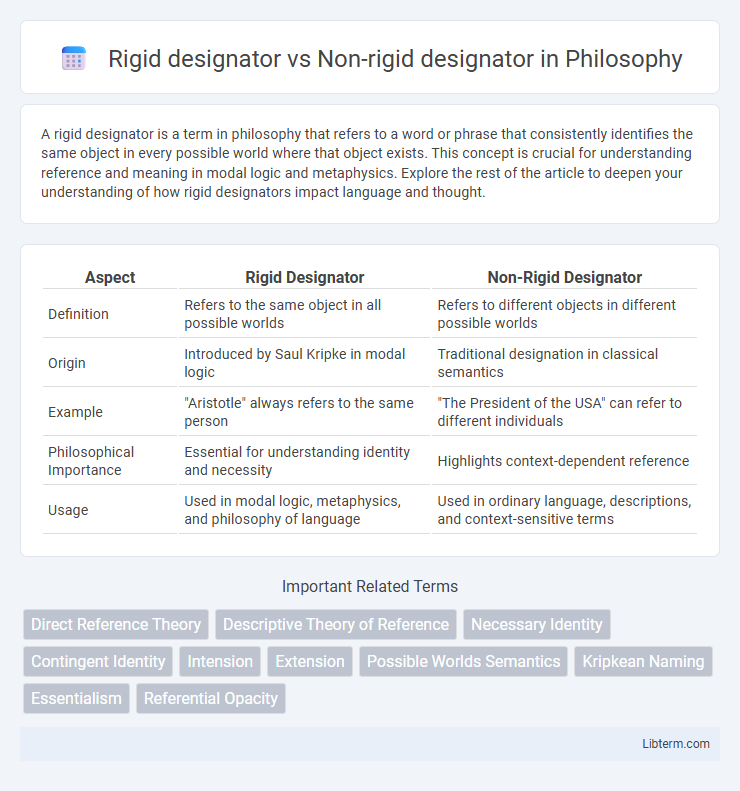A rigid designator is a term in philosophy that refers to a word or phrase that consistently identifies the same object in every possible world where that object exists. This concept is crucial for understanding reference and meaning in modal logic and metaphysics. Explore the rest of the article to deepen your understanding of how rigid designators impact language and thought.
Table of Comparison
| Aspect | Rigid Designator | Non-Rigid Designator |
|---|---|---|
| Definition | Refers to the same object in all possible worlds | Refers to different objects in different possible worlds |
| Origin | Introduced by Saul Kripke in modal logic | Traditional designation in classical semantics |
| Example | "Aristotle" always refers to the same person | "The President of the USA" can refer to different individuals |
| Philosophical Importance | Essential for understanding identity and necessity | Highlights context-dependent reference |
| Usage | Used in modal logic, metaphysics, and philosophy of language | Used in ordinary language, descriptions, and context-sensitive terms |
Introduction to Designators in Philosophy
Rigid designators refer to terms that denote the same object in every possible world where that object exists, exemplifying necessity in reference within modal logic. Non-rigid designators, or flaccid designators, identify different entities in different possible worlds, reflecting variability in reference depending on context or circumstance. The distinction, introduced by Saul Kripke, is crucial in understanding reference, identity, and meaning in philosophical logic and the philosophy of language.
Defining Rigid and Non-Rigid Designators
Rigid designators refer to the same object in every possible world where that object exists, ensuring their reference remains constant across all contexts. Non-rigid designators, also known as flaccid or accidental designators, can refer to different entities in different possible worlds, depending on descriptive attributes or circumstances. The distinction is crucial in modal logic and philosophy of language for understanding necessity and contingency in reference.
Origins of the Rigid Designator Concept
The concept of the rigid designator was introduced by philosopher Saul Kripke in his seminal work "Naming and Necessity" (1980), where he argued that certain terms refer to the same object in every possible world in which that object exists. Rigid designators contrast with non-rigid (or flexible) designators, which can refer to different entities depending on the context or possible world. This distinction challenged traditional descriptivist theories of reference and significantly influenced modal logic and the philosophy of language.
Saul Kripke’s Role in Naming Rigid Designators
Saul Kripke revolutionized the philosophy of language with his introduction of rigid designators, which refer to the same entity in every possible world, contrasting with non-rigid designators that can denote different entities depending on the context. His seminal work, "Naming and Necessity," argued that proper names are rigid designators essential for understanding reference and necessity in modal logic. Kripke's theory challenged descriptivist views, emphasizing the necessity of direct reference and the causal-historical chain in naming.
Examples of Rigid Designators
RIGID DESIGNATORS refer to terms that designate the same object in every possible world where that object exists, such as proper names like "Aristotle" and natural kind terms like "water." For example, "Aristotle" refers to the same historical philosopher in all conceivable scenarios, making it a prime example of a rigid designator. Non-rigid designators, by contrast, can refer to different entities depending on the possible world or context, such as descriptions like "the president of the United States.
Examples of Non-Rigid Designators
Non-rigid designators refer to terms whose reference varies across possible worlds or contexts, such as "the President of the United States" or "the tallest building in New York." These designators depend on specific conditions or roles that can change over time, making their referent non-fixed. For example, "the President of the United States" designates different individuals in different possible scenarios, unlike rigid designators like proper names.
The Significance in Modal Logic
Rigid designators consistently refer to the same entity across all possible worlds, ensuring stable reference crucial for modal logic analysis. Non-rigid designators can refer to different entities depending on the possible world, complicating necessity and possibility claims. This distinction supports precise evaluation of modal statements by clarifying how terms maintain or alter their reference in modal contexts.
Implications for Identity and Reference
Rigid designators consistently refer to the same entity across all possible worlds, preserving the identity of objects in modal contexts, which ensures clarity in reference during philosophical and linguistic analyses. Non-rigid designators, by contrast, may refer to different entities depending on context or possible worlds, leading to ambiguity in identity and complicating the tracking of reference. Understanding the distinction impacts theories of reference, essentialism, and possible-world semantics by clarifying how names and descriptions function in establishing identity conditions.
Criticisms and Alternative Perspectives
Rigid designators refer to the same object in every possible world, a concept introduced by Saul Kripke, but critics argue this notion oversimplifies reference by neglecting context-dependent meanings. Non-rigid designators, which can refer to different entities across possible worlds, face criticism for lacking the precision needed for modal logic and semantic analysis. Alternative perspectives propose hybrid approaches, integrating both rigid and non-rigid elements to capture the complexity of reference and meaning in natural language and metaphysics.
Conclusion: Rigid vs. Non-Rigid Designators in Contemporary Philosophy
Rigid designators consistently refer to the same entity across possible worlds, providing stability in modal logic and essentialist arguments. Non-rigid designators may refer to different entities depending on context or possible world, complicating reference and identity conditions. Contemporary philosophy leverages rigid designation to clarify necessity and identity, while recognizing non-rigid designation's role in context-dependent meaning and descriptive reference.
Rigid designator Infographic

 libterm.com
libterm.com